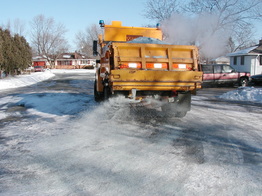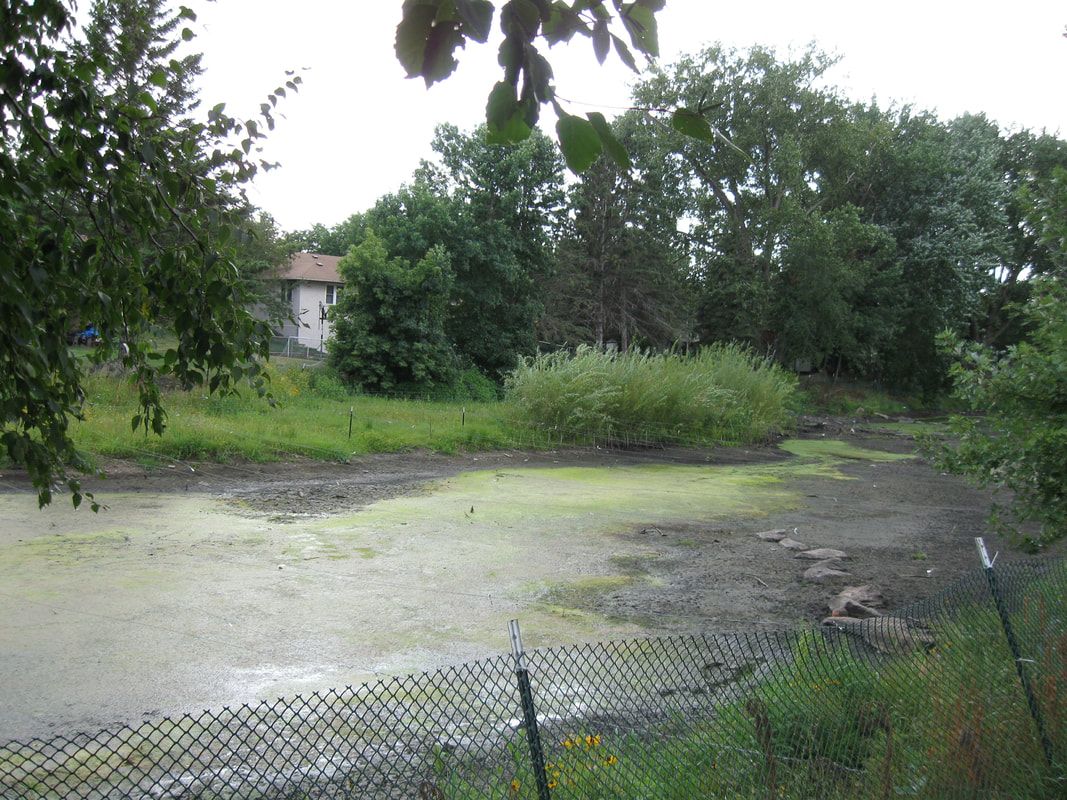Total Maximum Daily Load (TMDL) Studies
As mandated by the federal Clean Water Act, the State of Minnesota has established water quality standards for its lakes, streams, and wetlands. When monitoring data shows that a waterbody does not meet one or more standards, it is designated an Impaired Water. A TMDL study must be completed to identify the source or sources of impairment, how they should be addressed, and how much work needs to be accomplished to restore the waterbody to state standards. In many cases the waterbody receives too much of a particular pollutant. The TMDL study estimates how much pollutant is contributed to the waterbody, computes the maximum amount, or load, of a pollutant that a body of water can receive while still meeting water quality standards, and establishes the necessary load reduction. In Minnesota the Clean Water Act is administered by the Minnesota Pollution Control Agency. Thirteen lakes and two streams in the Shingle Creek watershed have been designated Impaired Waters. Three of the lakes - Lower Twin, Ryan, and Schmidt Lakes - have since been removed from the Impaired Waters list because water quality has improved, and two more lakes - Bass and Pomerleau - are expected to be removed in 2024. Approximately every five years the Commission will complete a Five Year Review of progress toward meeting the state water quality standards.
Learn More:
MPCA Impaired Waters and TMDLs
EPA Implementing The Clean Water Act
As mandated by the federal Clean Water Act, the State of Minnesota has established water quality standards for its lakes, streams, and wetlands. When monitoring data shows that a waterbody does not meet one or more standards, it is designated an Impaired Water. A TMDL study must be completed to identify the source or sources of impairment, how they should be addressed, and how much work needs to be accomplished to restore the waterbody to state standards. In many cases the waterbody receives too much of a particular pollutant. The TMDL study estimates how much pollutant is contributed to the waterbody, computes the maximum amount, or load, of a pollutant that a body of water can receive while still meeting water quality standards, and establishes the necessary load reduction. In Minnesota the Clean Water Act is administered by the Minnesota Pollution Control Agency. Thirteen lakes and two streams in the Shingle Creek watershed have been designated Impaired Waters. Three of the lakes - Lower Twin, Ryan, and Schmidt Lakes - have since been removed from the Impaired Waters list because water quality has improved, and two more lakes - Bass and Pomerleau - are expected to be removed in 2024. Approximately every five years the Commission will complete a Five Year Review of progress toward meeting the state water quality standards.
Learn More:
MPCA Impaired Waters and TMDLs
EPA Implementing The Clean Water Act
Twin and Ryan Lake Nutrient TMDL
The TMDL for this chain of four lakes was completed in 2007. The first lake in the chain, Upper Twin Lake, requires a 58% reduction in nutrient loads to the lake, while the other three - Middle Twin and Lower Twin and Ryan Lake - require a 12-19% reduction. A 5 Year Review was completed in 2014, which found that nutrient load from the watershed has been greatly reduced. Several large projects have been complete in the watershed, and a carp management program begun. The focus in the coming years will be on controlling rough fish and invasive aquatic vegetation and continuing to reduce pollutants from the watershed.
Learn More: TMDL and Implementation Plan Five Year Review Wetland 639W Outlet Modification Project SRP Reduction Project Twin Lake Carp Management Twin Lake Next Steps |
Shingle Creek Chloride TMDLShingle Creek was the first stream in the state to be designated an Impaired Water for excess chloride, found at the USGS monitoring station in 1996. Before that time, streams in Minnesota were rarely monitored for chloride, which is now found at high levels in numerous streams in the Metro area. The 2007 TMDL required a 71% reduction in chloride, mostly from road salt. A 5 Year Review was completed in 2014, which found that while road salt use has been reduced, there has been no improvement in stream water quality.
Learn More: TMDL and Implementation Plan Five Year Review Smart Salting |
Crystal Lake Nutrient TMDLCrystal Lake in Robbinsdale requires a 72% reduction in nutrient loading to consistently meet state water quality standards. Numerous small projects have been completed in the watershed, and in 2013 Robbinsdale constructed a hypolimnetic withdrawal system on the shoreline. Nutrient-rich water is pumped from the depths of the lake, treated, and then returned to the lake. A 5 Year Review concluded that the withdrawal system should continue to target the treatment of water pumped from the bottom of the lake, and that reductions in nutrient loading from the watershed should continue as opportunities arise. Since 2020 the Commission and City have been partnering to remove carp, undertake two alum applications to seal lake sediments, and treat invasive aquatic vegetation,
Learn More: TMDL and Implementation Plan Five Year Review Crystal Lake Management Plan Feasibility Memo |
|
Pomerleau, Bass, and Schmidt Lakes Nutrient TMDL
This three lake chain is located in Plymouth and a very small area of Maple Grove. The TMDL was completed in 2009. The City of Plymouth and the lakeshore owners have taken action to improve Schmidt Lake, and it is now been removed from the Impaired Waters List. The 5 Year Review concluded that internal load reductions were necessary for Bass and Pomerleau Lakes. Two alum treatments were applied to both lakes, in 2019 and 2020. The project also includes continuing treatment of aquatic invasive curly-leaf pondweed. Both lakes now meet water quality standards are will be removed from the Impaired Waters List in 2024.
Learn More: TMDL and Implementation Plan Five Year Review Bass and Pomerleau Alum Treatment Feasibility Study |
|
Cedar Island, Pike, and Eagle Lakes Nutrient TMDL
This three lake chain is located in Maple Grove and a small area of Plymouth. the TMDL was completed in 2010. Cedar Island Lake has a pumped outlet to Eagle Lake. Pike Lake is connected to Eagle Lake by a short channel through a wetland. Required nutrient load reductions range from 40% for Eagle to 67% for Cedar Island. A 5 Year Review completed in 2018 concluded that aquatic invasive curly-leaf pondweed management would be beneficial in Eagle and Pike Lakes, and that internal load management should be considered for Pike Lake. Cedar Island Lake has a high "residual load," meaning that the specific sources of excess nutrients to or in the lake has not yet been fully explained and requires additional study.
Learn More: TMDL and Implementation Plan Five Year Review |
|
Shingle and Bass Creeks Biotic Integrity and Dissolved Oxygen TMDL
Water quality standards also include standards for aquatic life. The fish and macroinvertebrate communities in Shingle Creek and its tributary Bass Creek have been found to be impacted by several stressors, resulting in a lack of species diversity. One significant stressor is low dissolved oxygen, which aquatic organisms need to survive. Both streams have been straightened and widened to better carry flood flows. However, this reduces habitat like rocky riffles and deeper pools that aerate the water. Based on the results of the 2011 TMDL and the Stressor Identification Report, Brooklyn Center, Brooklyn Park, and New Hope have all completed stream restoration projects to add habitat and dissolved oxygen. This TMDL will be reviewed in 2020.
Learn More: TMDL, Stressor ID Report, and Implementation Plan 2005 Shingle Creek Corridor Study |
|
Magda and Meadow Lakes Nutrient TMDLs
TMDLs have also been completed for two smaller lakes in the watershed, Lake Magda in Brooklyn Park and Meadow Lake in New Hope. Both these lakes are small, shallow lakes with very small contributing watersheds. Meadow Lake requires an 88% reduction in nutrients. The City of New Hope installed several load reduction practices when neighborhood streets were reconstructed. Lake Magda requires a 69% load reduction. A TMDL 5 Year Review was completed in 2019, and concluded that internal load management such as a drawdown and alum treatment and rough fish and aquatic invasive species management is necessary. In 2021 the Commission and City completed a Feasibility Study for internal load management and began implementation in 2021.
Learn More: Lake Magda TMDL and Implementation Plan Meadow Lake TMDL and Implementation Plan Meadow and Magda Lakes TMDL Five Year Review Meadow Lake Feasibility Report |







